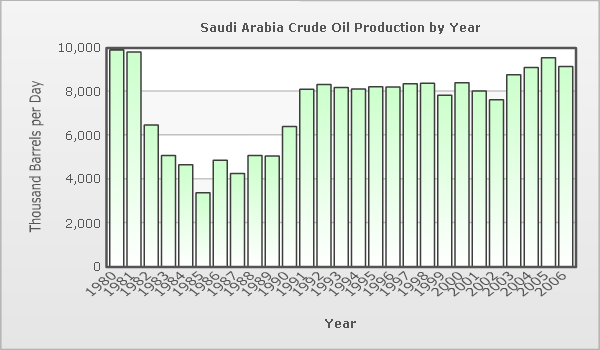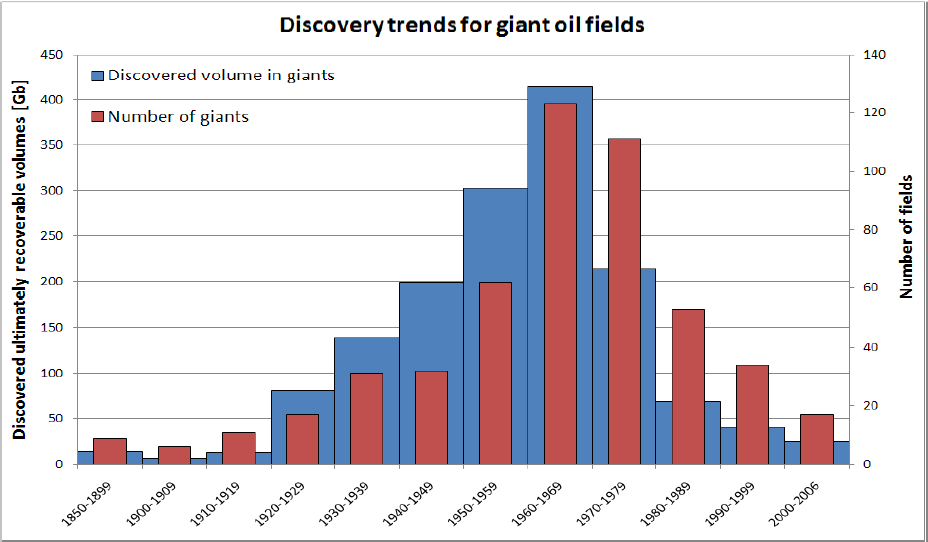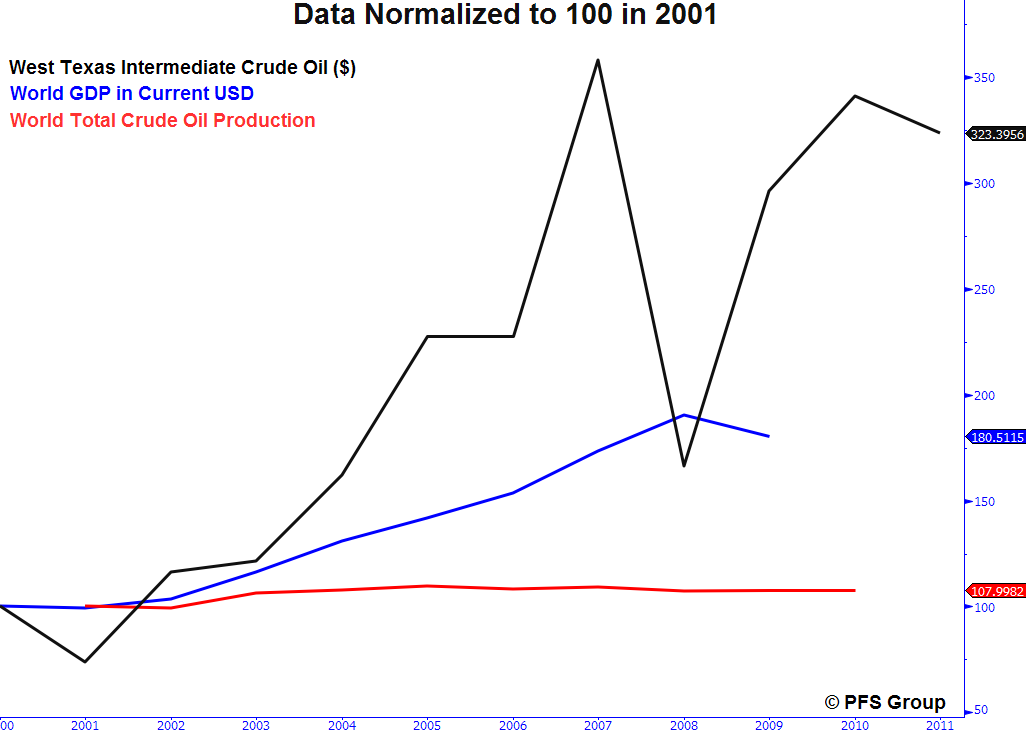If you live in the western world you never have to think about it. Flip a switch and the lights go on. Turn the faucet and the water flows freely for either your morning coffee or a shower. The grocery stores are filled with fruits and vegetables all year long. If the growing season ends here, the food is flown in from elsewhere around the world; fish and seafood from Asia, sugar and confections, fruits and vegetables from Latin America. We have everything we need. If we don’t produce it here we import it with little cost.
Our abundant and rich lifestyle is all made possible from cheap and abundant energy. Our farmers use fertilizers made from natural gas. The tractors and combines burn diesel fuel as do the trucks that transport our food to either processing plants or the grocery store. Our stores are stocked with goods that are either made here or abroad. The goods arrive by planes, trains, boats or trucks that also burn fossil fuels. Everything we eat, consume, or enjoy is made possible through the production of energy. Liquid fuels have created new landscapes of concrete and asphalt highways, parking lots, shopping centers and endless urban sprawl.
This is all made possible because of oil, the single most important source of primary energy in our world. Crude oil has changed the very tempo of modern life. Oil has increased the productivity of modern economies. It has accelerated as well as deepened the process of economic globalization. Refined fossil fuels power massive diesel engines, which has changed both freight, passenger, and waterborne transport from river barges, to transoceanic freight ships and oceanic liners. The current pace of globalization has been made possible through marine transport.
When we think of oil we think of transportation, the cars we drive to the jets we fly to our vacation destination. Oil, however, is used in a surprising number of other items we consume. One 42 gallon barrel of oil creates 19.4 gallons of gasoline. The rest (over half) is used to make other things.

Source: https://www.ranken-energy.com/Products%20from%20Petroleum.htm
Oil has changed and transformed the landscape of the world. It is a world we have taken for granted. It is this very lifestyle that we enjoy that is about to change in immeasurable ways this decade. What is going to change this world is the peaking of world oil production. Conventional oil, depending how you define it, has already peaked between the years 2004-2006. According to the IEA’s latest estimates, of the roughly 86 million barrels a day of oil that we consumed in 2009, 85% came from crude oil, 10% from natural gas liquids, 3% from other liquids, and 3% from refinery processing gains. We are already using other liquid fuels from deep water oil, tar sands, to coal and gas liquids to help supplement what we are currently not producing from conventional oil. Despite a seven-fold increase in oil prices this decade, global oil production has remained flat since 2005.
The question that needs to be raised and asked here is, despite a seven-fold increase in the price of oil this decade, why oil production has remained flat since 2005? Another issue that needs to be answered is despite projections made by experts of trillions of barrels of new oil that has yet to be found, why is it that we’ve been unable to replace the oil we consume each year by new discoveries? Our inability to replace what we consume has been occurring since the mid-1980’s.
The reason, I believe, is that we are no longer discovering or finding oil giants. As shown in the illustration below 20% of our oil comes from just 14 oil fields. Over 47 percent of our oil comes from just 116 oil fields. The rest comes from smaller oil fields. The simple reality is that a large portion of the world’s most important energy source, oil, comes from a small population of giant oil fields and we are simply not finding them anymore. Most of these giants were discovered 50 to 70 years ago. The biggest oil field in the world, Ghawar (Saudi Arabia), was discovered in 1948. Cantarell (Mexico) was discovered in 1976, Prudhoe Bay (Alaska) in 1969, and Burgan Greater (Kuwait) was discovered in 1938.

Source: Matthew R. Simmons, “The World’s Giant Oilfields,” 9 Jan 2002, p16
The definition of giants has changed over the decades. The world’s 19 largest “old giant fields” still produce an average over 500,000 barrels per day, in spite of an average age of almost 70 years1. Very few, if any oil fields currently under development are expected to have daily production in excess of 250,000 barrels per day. So when a giant oil field such as Ghawar, Cantarell, Burgan, Prudhoe Bay, or the North Sea goes into decline it has a major impact on global oil production. Current rates of discovery are fewer and smaller in size. In addition to being smaller their depletion occurs at a faster rate.
Despite the importance of oil to our modern technological and industrial economies, very few individuals or institutions have asked these important questions. Seldom has anyone attempted to analyze these oil giants. To my knowledge, the late Matt Simmons was one of the first to examine this issue. Simmons first looked into the matter at the beginning of the last decade. His analysis was reported in a paper he wrote for the M. King Hubbert Center in January of 2002. Prior to Simmons' investigation, virtually no analysis had been done on what the production rates of all the giant oilfields might be as the future unfolds.
Simmons' work in this area led to his next field of examination, the Saudi oil fields, the largest and highest producing oil fields in the world. His investigation led to his seminal book, “Twilight in the Desert - The Coming Saudi Oil Shock And The World Economy,” published in 2005. Matt's conclusion was that the twilight of oil that is approaching in Saudi Arabia and across the entire Middle East would make oil products more scarce and less affordable to developed nations and aspiring populations in underdeveloped countries. This would lead to growing scarcity and higher costs of the commodity underpinning our entire modern society. At some future point in time, large oil prospects will vanish completely, reserves will dwindle, and production will fall2.
Despite the seven fold increase in oil prices this past decade, Saudi oil production has hardly budged. Why experts outside the peak oil camp don’t find this alarming is hard to comprehend. Most oil demand estimates and supply studies that you find today still argue that the bulk of future oil demand will be met by OPEC, especially from Saudi Arabia. If Saudi Arabia was unable to exceed the limits of their production reached back in 1980 how can we be confident they will be able to exceed them in the future, even when oil prices rise above and beyond 0 a barrel.

Source: https://www.indexmundi.com/energy.aspx?country=sa&product=oil&graph=production
Since Simmons first looked into the matter others have now followed. The IEA did a major study in 2008 of the world’s 800 largest oil fields. Their study found that field-by-field declines in oil production were accelerating. “We estimate that the average production-weighted observed decline rate worldwide is currently 6.7% for fields that have passed their production peak. In our Reference Scenario, this rate increases to 8.6% in 2030. The current figure is derived from our analysis of production at 800 fields, including all 54 super-giants (holding more than 5 billion barrels) in production today. For this sample, the observed post-peak decline rate averaged across all fields, weighted by their production over their whole lives, was found to be 5.1%. Decline rates are lowest for the biggest fields: they average 3.4% for super-giant fields, 6.5% for giant fields and 10.4% for large fields. Observed decline rates vary markedly by region; they are lowest in the Middle East and highest in the North Sea3.”
In their summary, the IEA wrote the following: “The world’s energy system is at a crossroads. Current global trends in energy supply and consumption are patently unsustainable — environmentally, economically, socially. But that can — and must — be altered; there’s still time to change the road we’re on…Time is running out and the time to act is now.”
Unfortunately, their message went unheeded. Their study called for a future investment in 2007 dollars, of trillion to be made from 2007-2030 in order to meet future world energy demands. We’re not even close to reaching that figure. The 2008 IEA report was a seminal work whose message was released at the wrong time. In November 2008 the world was immersed in the worst credit crisis since the 1930’s Great Depression. The message remains the same; oil depletion is accelerating and needed investments are not being made that will enable us to meet future demands for energy.
Chris Skrebowski, formerly of Petroleum Review, did a study of the world’s large oil fields. His “Megaprojects” study paints an alarming view of present and future projects coming on line in this decade. If oil depletion is accelerating then new oil discoveries must be made and brought on line to keep us even and meet future energy demand. As shown in the table below, given the number of oil fields globally that will come on line between now and 2015 many experts are predicting a major oil crunch somewhere between now and then.

Source: Peak Oil Consulting; table in “The Oil Crunch,” UK ITPOES, February 2010, p 19, table 3.1
It's no longer a question of if but when. The only thing that may delay its arrival is another global recession similar to the one we just experienced where global oil demand fell by over 2 million barrels a day. Frankly, I’m not aware of any economists or politicians that are proposing another recession as a means of solving world energy demand or avoiding higher energy prices, however, many of their actions (or inactions) only serve to further accelerate the problem as it approaches.
In their study of giant oil fields, Michael Höök, Robert Hirsh, and Kjell Aleklett point to the alarming trend in their overall production. Many of them are now 50 years old or more, in decline, and without a sufficient number of new giants being discovered to replace growing demand. This disturbing fact is illustrated below by the following graph:

Source: https://www.postpeakliving.com/files/shared/Hook-GOF_decline_Article.pdf
Giant oil fields represent roughly 65 percent of global conventional oil resources that are ultimately recoverable. The top 500 fields account for 60 percent of world oil production, with the top 20 fields responsible for 25 percent of global production.
If we are making fewer oil discoveries, and the discoveries we are making are smaller than the giants of the past, and world oil depletion is accelerating then “Houston we have a problem.” We better start spending more money on investment, accelerating existing projects, and working on alternative views or we will face another oil crunch in the not too distant future.
The importance of the giant oil fields is grossly under estimated. Our giant oil fields provide the bulk of our energy needs. They are old, many of them have already peaked, and their depletion rates are accelerating. We have nothing on the horizon to replace them. Their importance in meeting future oil production was the recent study of a doctoral dissertation by Fredrik Robelius at Uppsala University. Robelius studied the giant oil fields with the aim of being able to predict when global oil production will occur. In his chapter on peak oil Robelius concluded the following: “Clearly, it is easy to reject the notion of a global peak oil today with respect to those earlier crises, but there is one big difference: no one is deliberately closing any valves today, on the contrary, all valves are open and production is more or less maximized. However, another question that should be asked is to what extent the oil price is a valid parameter for predicting a future peak oil. Another more important parameter for future oil production and the predictions of a peak oil is the giant oil fields, i.e. the largest oil fields in the world.”4
As shown in the table below from Robelius’s work, the top 18 oil fields in the world were discovered 50-70 years ago with the oldest giant, Bolivar Coastal discovered in 1917.

Source: Frederik Robelius, "Giant Oil Fields," 30 March 2007, p79
Robelius ends his dissertation with four possible future scenarios:
- Worst Case
- Standard Case- Low End
- Standard Case- High End
- Best Case
Under the worst case scenario, declining production started around 2006. In the low end estimate of the standard case, production starts to decline in 2012, the high end production declines after 2011, and under the best case scenario the decline begins after 20145. Robelius’s assumptions seem to be in line with the myriad reports predicting peak oil published last year. They seem to line up in parallel with the UK Industry Task Force on Peak Oil & Energy Security’s “Oil Crunch" report issued in February of 2010. The UK Task Force issued a time frame of low oil prices during recovery to 2011, supply satisfies economic growth, 2011-2013, and tightening oil supplies 2014-2015, with recessionary forces and volatile prices from 2015 on.
It would appear that the peak in oil prices could already be here, or at best not too far distant from today. As the late Matt Simmons noted, we will only know about the peak long after it has already passed. What we do know is that the rate and size of discoveries have been declining since the late 1960’s. In the last several decades we have discovered very few giant oil fields. The ones that we have discovered have been discovered in deep waters off shore where the technology to extract the oil is yet to be invented. Whether the decline begins gradually, or oil production follows an undulating plateau we will only know in hindsight. The fact that we have no verifiable data on which to draw on makes the task of prediction much more complicated.
As important as oil is to the world economy, the energy industry lacks transparency. Without a verifiable audit of the world’s largest oil fields we are left with assumptions, conjecture, and speculation as to when the peak will occur. What we can conclude is this, the giant oil fields make up the bulk of the world's oil production and reserves, and they are aging and depleting. Global oil discoveries peaked in the late 1960s and we haven’t replaced what we consume each year since the mid-1980s. I’ll leave the reader to draw their own conclusions.
A prudent person foresees danger and takes precautions. The simpleton goes blindly on and suffers the consequences.
Proverbs 27:12 NLT
[1] The World’s Giant Oilfields, by Matthew R. Simmons, p.5
[2] Twlight in the Desert, by Matthew R. Simmons, p 341-344
[3] IEA World Energy Outlook 2008, p. 43
[4] Giant Oil Fields-The Highway to Oil-Giant Oil Fields and Their Importance for future Oil Production, by Fredrik Robelius, Uppsala Universitet, p. 73
[5] ibid, p. 125-129







